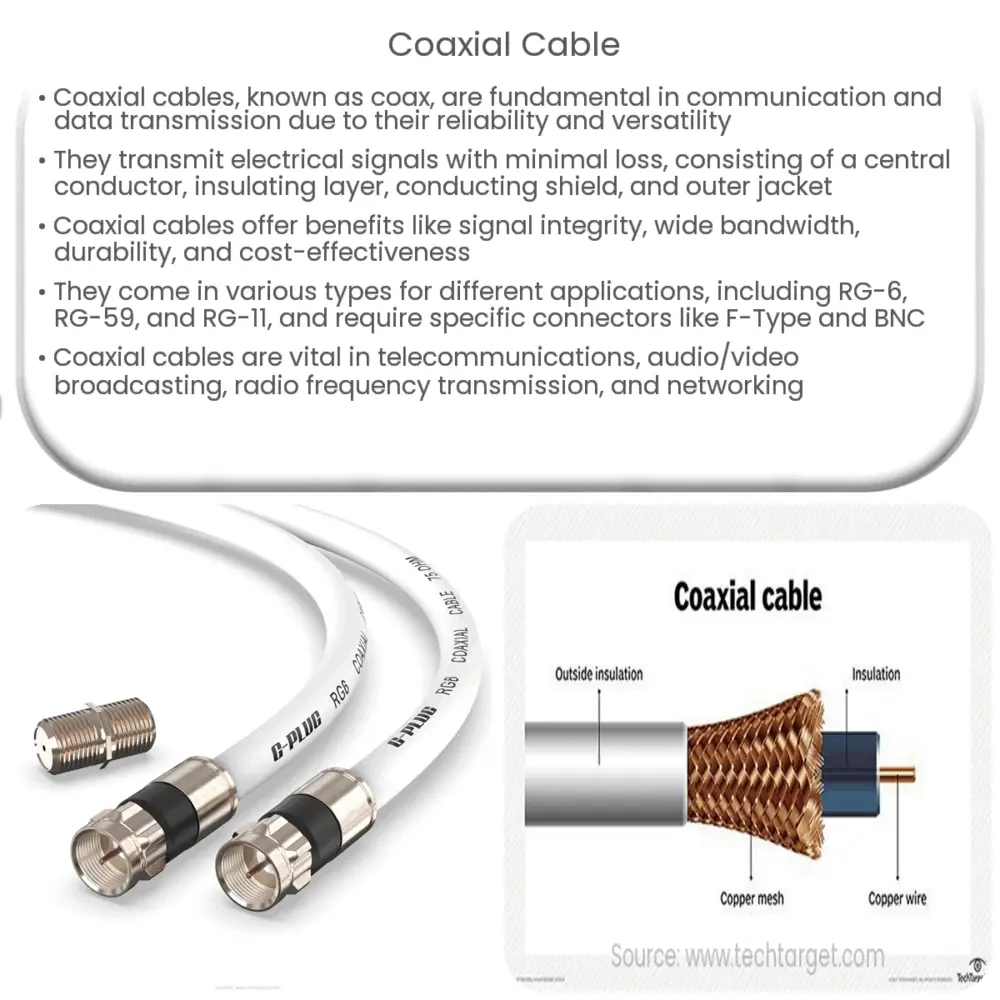Coaxial cables transmit electrical signals with minimal loss, offering signal integrity, bandwidth, and durability across various applications.

Understanding Coaxial Cables: An In-Depth Guide
Introduction
Coaxial cables, commonly known as coax, have been a staple in communication and data transmission for many years. Despite the advent of new technologies, they continue to be an essential component in various applications due to their reliability, durability, and versatility. In this article, we will explore the fundamentals of coaxial cables, their construction, types, and various uses in the modern world.
What is a Coaxial Cable?
A coaxial cable is a type of cable used for transmitting electrical signals, primarily radio frequency (RF) signals, with minimal signal loss and interference. Coaxial cables consist of a central conductor wire, usually made of copper or copper-clad steel, surrounded by a layer of insulating material known as a dielectric. This dielectric is then enclosed by a conducting shield, which is typically a braided wire mesh or a foil layer. Finally, an outer insulating jacket made of PVC or another type of plastic material protects the entire assembly.
Advantages of Coaxial Cables
Coaxial cables offer several advantages over other types of communication cables, such as twisted pair and optical fiber. These advantages include:
- Signal Integrity: Coaxial cables maintain signal quality by reducing electromagnetic interference (EMI) and radio frequency interference (RFI) due to the shielding provided by the conducting layer.
- Bandwidth: Coaxial cables can support a wide range of frequencies, making them ideal for high-speed data transmission and broadband applications.
- Durability: The robust construction of coaxial cables allows them to withstand harsh environments and resist physical damage, ensuring long-lasting performance.
- Cost-effectiveness: Coaxial cables are generally more affordable than optical fiber cables, making them an attractive option for cost-conscious installations.
Types of Coaxial Cables
Coaxial cables come in various types, each designed for specific applications and requirements. The most common types of coaxial cables include:
- RG-6: RG-6 is the most widely used type of coaxial cable, typically employed for cable television, satellite television, and internet connections. It has a larger center conductor and thicker dielectric compared to other types, offering lower signal loss and improved performance.
- RG-59: RG-59 is commonly used for short-distance applications, such as connecting security cameras and closed-circuit television (CCTV) systems. It has a smaller diameter and is more flexible than RG-6, making it suitable for tight spaces and installations with many bends.
- RG-11: RG-11 is a high-capacity coaxial cable designed for long-distance installations and high-frequency applications. It has a larger diameter and lower signal attenuation than RG-6, making it ideal for use in commercial and industrial settings.
Coaxial Cable Connectors
To establish a connection between devices, coaxial cables require compatible connectors. Some of the most commonly used coaxial cable connectors include:
- F-Type: F-Type connectors are the standard for cable television, satellite, and antenna connections. They provide a secure, screw-on connection and are widely used with RG-6 and RG-59 cables.
- BNC: Bayonet Neill-Concelman (BNC) connectors are commonly used in professional video and audio applications, such as broadcasting and CCTV systems. They offer a quick and secure push-and-twist locking mechanism.
- SMA: Sub-Miniature Version A (SMA) connectors are used in high-frequency applications, such as microwave and radio communication systems. They are compact and provide excellent electrical performance up to 18 GHz.
- N-Type: N-Type connectors are designed for high-power, low-loss applications and can handle frequencies up to 11 GHz. They are commonly used in cellular and wireless communication systems, as well as radar and satellite installations.
Coaxial Cable Applications
Coaxial cables are employed in a wide range of applications across various industries, including:
- Telecommunications: Coaxial cables are used for broadband internet and cable television services, providing high-speed data transmission and reliable connectivity.
- Audio and Video: Coaxial cables are utilized for transmitting high-quality audio and video signals in professional broadcasting, home theater systems, and security camera installations.
- Radio Frequency: Coaxial cables are essential for transmitting radio frequency signals in applications such as ham radio, wireless communication systems, and radar installations.
- Networking: Coaxial cables can be used for local area network (LAN) installations, particularly in environments where high levels of interference may be present.
Conclusion
Coaxial cables have been a reliable solution for transmitting electrical signals for many years, and they continue to play a vital role in various industries. Their construction ensures signal integrity, bandwidth, and durability, making them suitable for a wide range of applications. By understanding the types of coaxial cables, connectors, and their uses, you can select the appropriate cable for your specific needs and ensure the best possible performance in your installation.

